Jawed, cartilaginous fish
General Characteristics:
- Sharks, skates, rays, ratfish
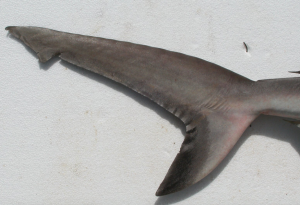
Figure 1: Heterocercal caudal fin - Appeared ~450 million years ago.
- Paired fins.
- Cartilaginous skeleton (complete)
- Heterocercal caudal fin (not symmetrical – vertebral column runs into caudal fin).
- No swim bladder.
- Almost all are marine
Sharks of British Columbia [infographic]
(Fun fact: Bull Sharks can live in both fresh and salt water and have been known spotted 4000km up the Amazon river, in Ganges river, the Mississippi, and in Lake Nicaragua!)
How bull sharks survive in freshwater [website]
Major evolutionary advancement: JAWS!

- Jaws developed over time from the gill arches, which support the gills, of jawless fish. (Homologous – derived from the same thing – to gill arches)
Question: What benefits would having a jaw confer to an organism?
- Many believe the jaw developed first as a way to increase respiratory efficiency – eating was a secondary function!
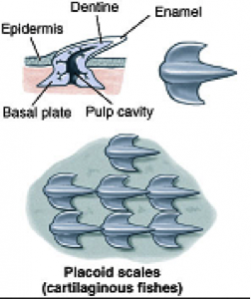
Figure 3: Placoid scales
Anatomy – Integument: Placoid scales
- Structurally similar to vertebrate teeth (homologous)
- Made of dentine surrounded by enamel. Nutrients supplied by blood vessels.
- These scales make their skin so rough it can be used as sand paper!
As with all fish, sharks/relatives have a lateral line, which gives them a “sixth sense” to detect vibrations in water.
However, Chondrichthyans also have special sensing organs called the Ampullae of Lorenzini giving them a “seventh sense.”
Anatomy and Physiology – Ampullae of Lorenzini
- Ampullae of Lorenzini are electroreceptors which detect electrical fields given off by muscle contractions of living things.
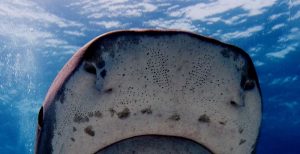
Figure 4: Close up of a shark rostum – notice the series of dots scatter throughout. These are the Ampullae of Lorenzini - That electrical signal goes through fluid filled pores and strike nerves to signal the brain.
- Can find hidden prey, differentiate patterns (i.e. injured/weakened prey)
Fun fact: Sharks can use their ampullae to navigate the globe by tracking earth’s electromagnetic field. This orients them and helps with migration. (Campagno et al. 2005). Hammerhead sharks are one such migratory shark.
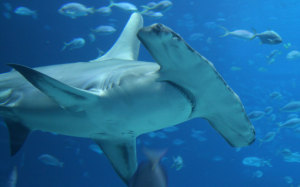
Hammerhead sharks have evolved to have more ampullae due to the evolutionary benefits conferred.
More on Hammerhead Sharks [Video – discovery]
Ampullae of Lorenzini additional information [Website]
Physiology – Digestive System
- More complex then in class Agnatha.
- Have a U-shaped stomach (Not as complex as humans)
- Stomach leads to the intestine which is called the spiral valve.
- Intestines are short, but have folds arranged in a spiral (increasing surface area).
- This leads to a cloaca – an opening for the urinary, digestive, and reproductive systems (one hole for all!)
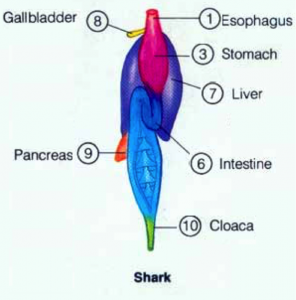
Sharks/relatives also have an enlarged liver (up to 20% of the weight of the fish) that produces lots of oil. The principle component of shark liver oil is called squalene.
Question: Why would a shark – a free swimming fish – want to produce a lot of oil?
Physiology – Reproduction
- Sharks/relatives produce less offspring than other fish, but they are larger and typical survive longer. (More energy into offspring = less offspring produced that have higher survival rate)
- Long gestation (development of offspring) and take a long time to reach maturity.
- Internal fertilization (Sperm and egg join inside the body of a parent).
- External fertilization (Sperm and egg join outside the body of a parent).
Many different forms:
Oviparous (“Egg Laying”)
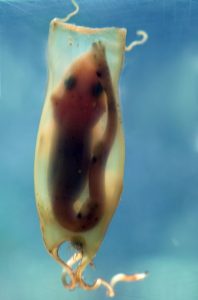
- Some lay eggs on the bottom and the baby sharks (pups) develop in a mermaid purse (egg case).
- Nutrients from yolk sac inside the egg.
- Ex. Horn Shark (Heterodontus francisci)
Viviparous (“live bearing”)
- Develop inside mother
- Get nutrients from umbilical cord (like humans)
- Births live young.
- Ex. Great Hammerhead (Sphyrna mokarran)
Ovoviviparous (“Aplacental yolk sac viviparous”)
- Mother produces eggs (like oviparous system) but carries the eggs inside until they hatch.
- Nutrients from yolk sac.
- Births live young that lived off a yolk sac inside an egg.
- Ex. Spiny Dogfish (Squallus acanthias)
Intrauterine cannibalism
- Similar to ovoviviparous.
- Mother produces up to 50 pups in each of two uteruses
- The first pup to be able eats all of the other pups.
- Two large pups are born live.
- Ex. Sand tiger shark (Carcharias taurus)
We typically think of oviparousity as the most primitive and viviparousity as more advanced.
Comparing reproductive methods in sharks [Video] – This is a great resource for clarifying these methods!
Question: What does that mean for ovoviviparous organisms in terms of the evolutionary continuum?
Important note: Oviparous, viviparous, ovoviviparous are not terms exclusive to sharks! These terms can be used across animals to describe reproductive method! (Example: Humans are viviparous)
Chondrichthyan spotlight (You don’t have to write this down):
Greenland Sharks (Somniosus microcephalus)

Greenland shark hunting – BBC Life [Video]
- Has a high concentration of a toxin – trimethylamine N-oxide – which causes the meat to be toxic if not treated.
- Can grow up to 7.3 m (24 ft) and more than 1,400 kg (3,100 lb).
- Often has a parasite on its eye, causing it to be nearly blind. However, preliminary studies believe the parasite can act as a lure for prey giving the shark a a benefit as well.
Most importantly:
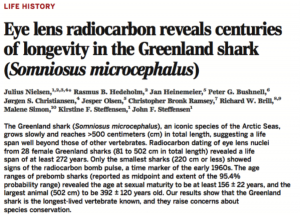
Is the longest-lived vertebrate animal known – at 392 ± 120 years! They don’t reach sexual maturity until 156 ± 22 years!
Extra questions:
- Describe how the Ampullae of Lorenzini helps Chondrichthyans navigate and migrate.
- Outline four reproductive methods found in Class Chondrichthyes. Which one is exclusive to this class?
- Explain how a shark is able to maintain buoyancy.
- What is the spiral valve? Describe its form and function.
- Describe the structure of placoid scales. What are they homologous to?
- Outline the development of jaws in vertebrates. Include what previous structure the jaw is thought to have evolved from.
- What is the difference between external and internal fertilization? Give an example for each method.
One last resource (not testable) – a 2006 documentary about shark finning called “Sharkwater” has been uploaded in its entirety by the creator. If you are interested in conservation issues or sharks, check it out! There are so many misconceptions about this class of vertebrates; education is the first step to protecting sharks – which in turn will help protect food webs and biodiversity in our oceans.
(Note: It is rated PG but there are some graphic scenes involving shark finning)
Sharkwater (2006) [Vimeo] Running time 1 hour 30 minutes
Shark infographic [infographic]
Comments by shaun pletsch